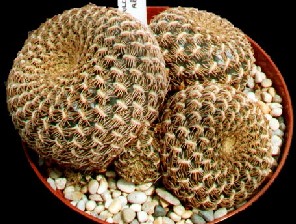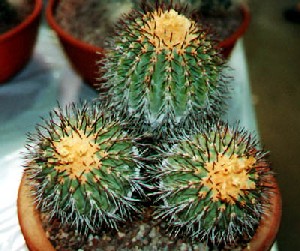
CACTI - Ever heard of those wonderful desert plants called the CACTI. You can grow these mystic and beautiful plants in your garden. It is seen that, most of the gardeners grow flowers, annuals, perennials, evergreen shrubs, fruit and decorative trees but do not venture the world of one of the most beautiful fauna called Cacti.
Cacti are a group of plants that add to the beauty of a garden. Every gardener if he has some extra space must grow at least of a few of the known varieties.
The Cacti come in un-imanagenable shapes and sizes. Some of them resemble the human brain. There are varieties which resemble small stones. Some are covered with what looks like fine white hair, while others have large hooked spines.
They do not droop or sulk at house temperatures, and compared to many houseplants, they need little care. In the winter, you barely need to water them, and in the summer, you can put them outside.
You must understand that Cacti do not easly adapt to the garden’s daily routine. If their requirements are met with, they flourish; otherwise they fall sick and die. Once affected they hardly survive.
We give below a few tips on growing cacti successfully. Make sure that you give your cacti a chance to live and grow.
Soil:
Make your own mixture: It is advisable that you make your own potting mixture. Collect the compost made from your vegetable kitchen waste and leaves, weeds and other waste from the garden.
Alternatively you can purchase it from a good nursery. First of all it should be sieved to ensure that there are no pieces of un-decomposed vegetable matter left in it. If any, it should be removed.
Take an old teacup or any other suitable container. Take four parts of the compost measured with the help of the teacup/container and to it add one cup of the sand and 2 mm flint/quartz pieces.
Transfer this mixture to a stainless steel container. Add sufficient rainwater or distelled water to ensure a moist consistency and seal the same.
Heat the sealed container in an oven at 120 deg C for 2 hours. This treatment is essential to kill insects, larvae, eggs and seeds which may be present in the compost or the soil.
Light Requirement: The Cacti love light. A sunny area of the garden can be your choice for the Cacti garden. The flowering variety of Cacti will grow under lower availability of light but invariably will not bloom.
Water Requirement: A cactus like any other garden plant needs water but their requirement is very small as compared to the other plants in your garden. The water requirement is season based. During the active growing season (spring and summer), they should be watered like normal houseplants.
Apply water every week or so, letting the soil mixture dry out completely between watering. During the winter, however, cacti go dormant, and should only be watered occasionally say ever 15 days but ensure that they do not die out.
The Cacti should be watered to wet their roots and not to flood them as standing water just kill them.
Fertiliser Application: Fertiliser should only be given to cacti during their active growing period. Liquid fertilizer specially formulated for cacti, should be applied with the watering routine in the summer.
The best liquid homemade mix is made as under:
Take 500 ml water and to it add 100 gm urea, 200 gm super phosphate and 50 gm potash. Mix it well just before application. A table full spoon of it should be applied to each pot every 15 days.
Temperature: Cacti grow best at the normal house temperature during their active growing period. The ideal temperature for the cacti is 25 C degree during day time and 20 degree C at night. During winter which is their dormant period the can survive even at 5 to 10 degrees C.
Repotting: Like most of the garden plants grown in containers the Cacti must be repotted every year. The safest way to handle the cacti while repotting is to wear garden gloves or wrap multiple layers of old cloth on your hands since cacti comes with thorns. You can also use a towel to wrap it around the plant while lifting it from the pot.
Before undertaking the process repotting prepare the soil mixture as given above and also arrange the new pots. The new pot should be a little larger than the old one since the root ball has during the last one year grown bigger.
Put a layer of broken pot pieces, small stones and gravel, at the bottom of the pot to ensure good drainage. Fill about a quarter of the pot with the soil mix. Lift the Cacti out of the old pot after loosening the soil and remove the old soil. Wash the roots and dip it in a mixture of 20 ml Dimethoate in 1 liter of water to disinfect it.
Next carefully place the cacti in the new pot. Pack the soil mixture around it and firmly. Allow the cacti to rest for a week or two before watering it, to give the broken roots a chance to heal.
How do Cacti look like? The Cacti are most beautiful, colourful, and impressive plants. When in bloom they are spectacular and fascinating.
If you are a cacti fan, you'll definitely wish to visit and see them for your self. At Panchkula (Haryana) there is a Cacti Garden
Excess water is most dangerous for the Cacti. Never leave cacti and succulents standing in water for prolonged periods as this will definitely kill them.
Since the Cacti are affected by the various minerals, salts, calcium and chlorine present in the tap water it is best to apply only boiled water to the Cacti plants.
Clean rain water is preferable to tap water, and a little fertiliser (Cactigrow or balanced Chempack) should be added to each watering throughout the growing period. Rainwater can be collected from the house roofs in plastic containers.
To stop mosquitoes and other insect larvae from breeding in your rain water containers put a few drops of olive oil or other vegetable oil on to the top of the water. The oil spreads out and forms a film on the top of the water that stops the mosquito larvae from breathing air through the water surface. Renew the oil every week through the summer..
Clean water can also be obtained from ice forming in refrigerators and freezers and from condensation from air conditioning units.

